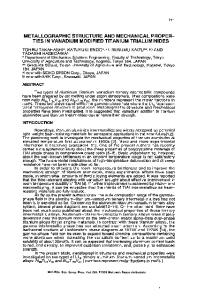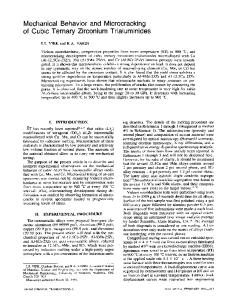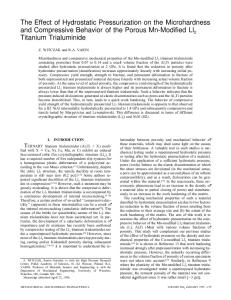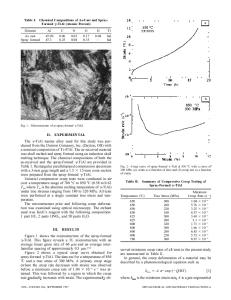Microhardness and compressive mechanical behavior of L1 2 titanium trialuminides
- PDF / 2,786,643 Bytes
- 12 Pages / 597.28 x 785 pts Page_size
- 40 Downloads / 400 Views
.
INTRODUCTION
IN a previous article, [1] a detailed microstructural characterization o f L12 AI3Ti + C u , F e , Mn, and Cr trialuminides, including their lattice parameters and the long-range order parameter S, was presented. The most interesting finding is a decrease in the long-range o r d e r parameter S with increasing titanium content in the homogenized L12 titanium trialuminides. The mechanical behavior o f L12 titanium trialuminides has been systematically studied in our laboratory. In the present article, we report and discuss the results o f Vickers microhardness and compressive testing at various temperatures o f L12 titanium trialuminides. The results o f mechanical testing will be discussed in terms o f the longrange order parameter S and within the framework o f ductile-to-brittle transition theory. II. • E X P E R I M E N T A L P R O C E D U R E
Compression testing at temperatures from liquid nitrogen temperature to 900 °C was carried out on cuboidal specimens (4 × 4 × 5 mm) spark-cut from the ingots induction-melted as described in Reference 1. The initial strain rate was 3 × 10-4 s -1. 0.2 pct offset yield strength was calculated as shown in Reference 2. Maximum permanent deformation at ultimate compressive strength (UCS) (apparent ductility) was determined by measuring the height o f the specimen (before and after the test) with a high accuracy micrometer (ep = Ah/ho, where h0 is initial height); UCS is the maximum stress just p r i o r to M.B. WINNICKA, Ph.D. Candidate, and R.A. VARIN, Professor of Materials Science and Engineering, are with the Department of Mechanical Engineering, University of Waterloo, Waterloo, ON N2L 3G1, Canada. Manuscript submitted July 2 2 , 1992. METALLURGICAL TRANSACTIONS A
fracture. The compressive pushing rods installed on the Instron machine were made o f INCONEL* a l l o y , and *INCONEL is a trademark of Inco Alloys International, WV.
Huntington,
the round TiC inserts, 16 mm in diameter, were mounted in the top and bottom rods' platens. The specimen's surfaces in contact with the platens were mechanically polished p r i o r to the test. In o r d e r to check if there was any effect o f the frictional forces at the specimen/platen interface t31 on the mechanical behavior o f material, some tests were carried out with a lubricant. At room temperature, a VASELINE* grease *VASELINE is Greenwich, C T .
a trademark of Cheseborough-Ponds,
Inc.,
was used, and at elevated temperatures (800 °C and 900 °C), Deltaglaze No. 19 by Acheson Colloidal was used. Within the range o f stresses and deformations obtained in the present work, there was no systematic difference between the mechanical properties o f lubricated and nonlubricated specimens. In order to r e v e a l a grain structure, polished specimens were etched with the mixture o f 46.2 ml H~O, 46.2 ml HF, and 7.6 ml HC1. Good results were obtained with AI3Ti + Mn and Cu specimens. However, A13Ti + Cr and Fe specimens were difficult to etch; i.e., the entire surface o f the specimen seemed to be attacked evenly. S
Data Loading...











